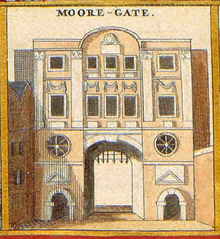
Back Μούρφιλντς Greek Moorfields Spanish Moorfields French Moorfields Irish Moorfields Italian Мурфилдс Russian Moorfields Swedish Moorfields Turkish
51°31′05″N 0°05′19″W / 51.518188°N 0.088611°W


Moorfields was an open space, partly in the City of London, lying adjacent to – and outside – its northern wall, near the eponymous Moorgate. It was known for its marshy conditions, the result of the defensive wall acting as a dam, impeding the flow of the River Walbrook and its tributaries.[1]
Moorfields gives its name to the Moorfields Eye Hospital which occupied a site on the former fields from 1822–1899, and is still based close by, in the St Luke's area of the London Borough of Islington.[2]
- ^ "Introduction: Geological and geographical setting | British History Online". www.british-history.ac.uk. Retrieved 23 October 2024.
- ^ "Our history - Moorfields Eye Hospital". www.moorfields.nhs.uk. Retrieved 23 October 2024.